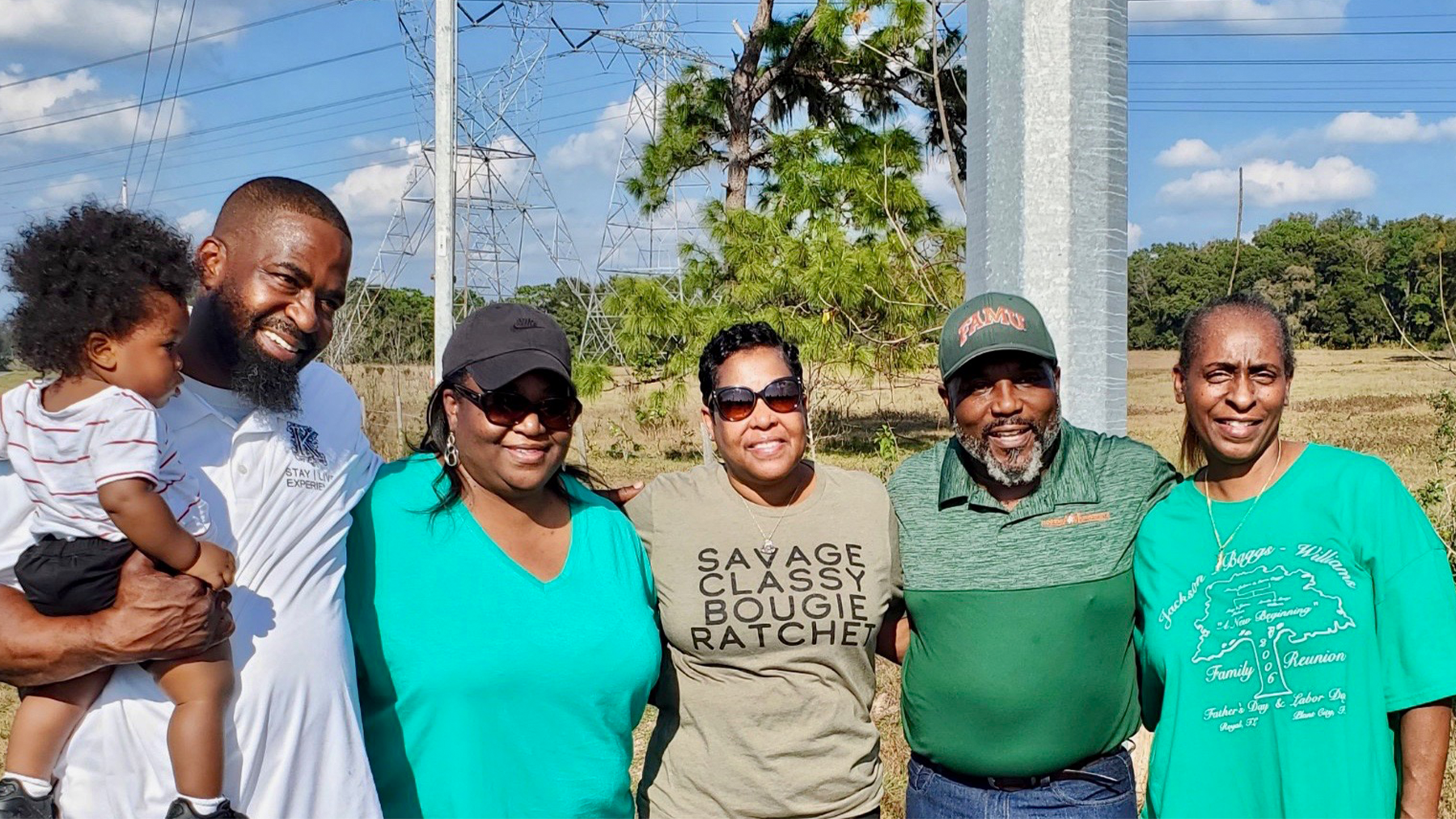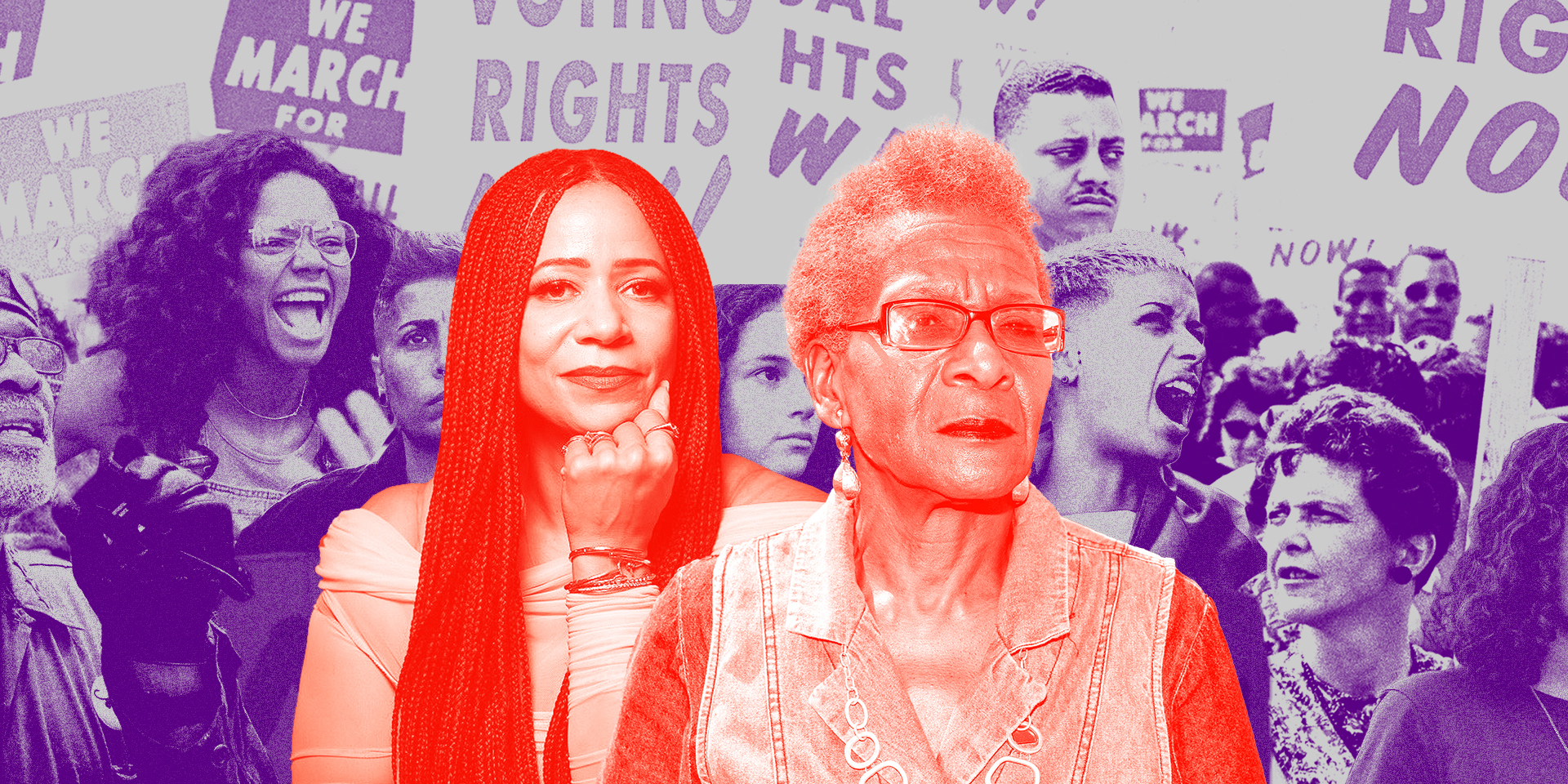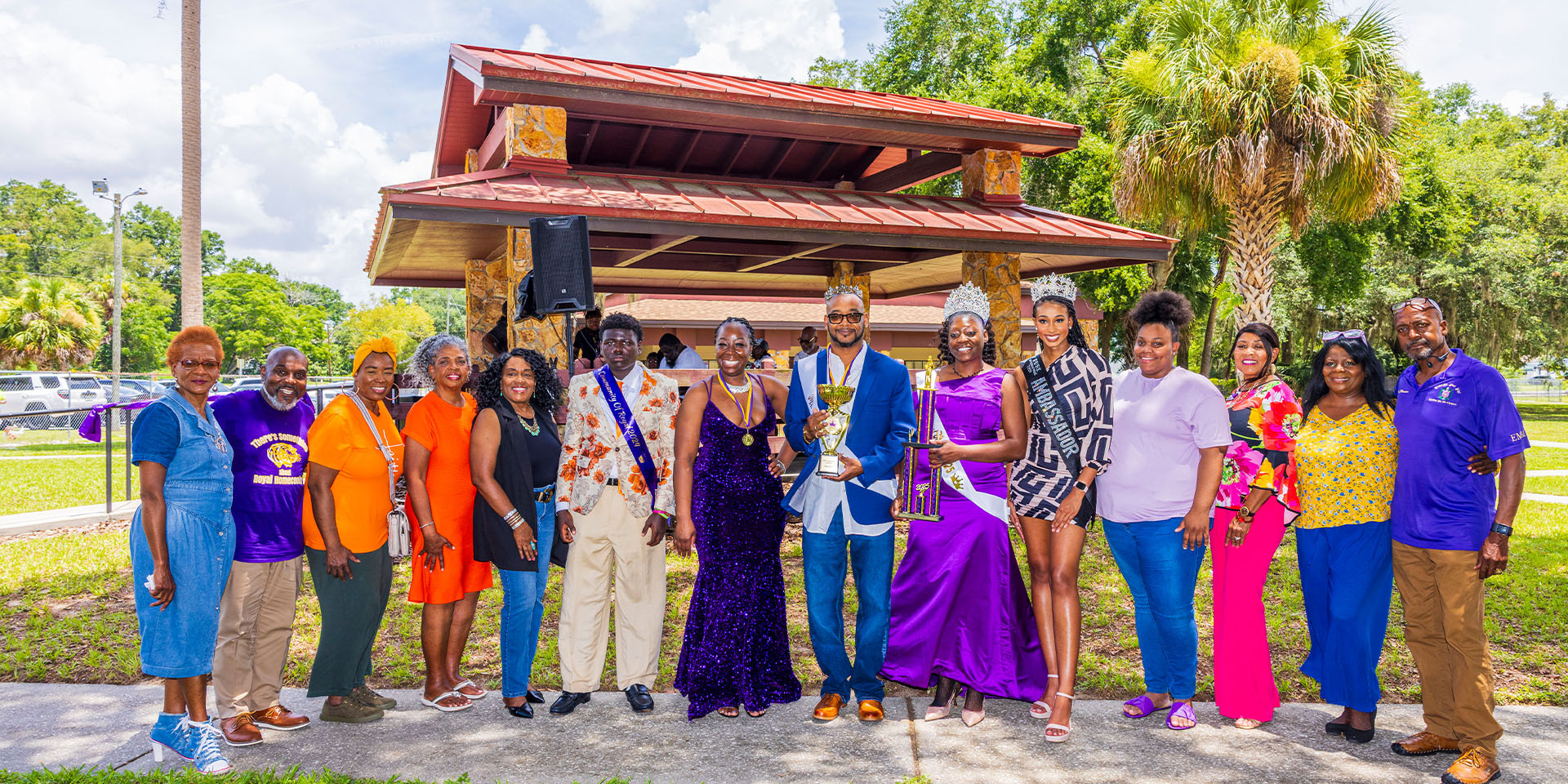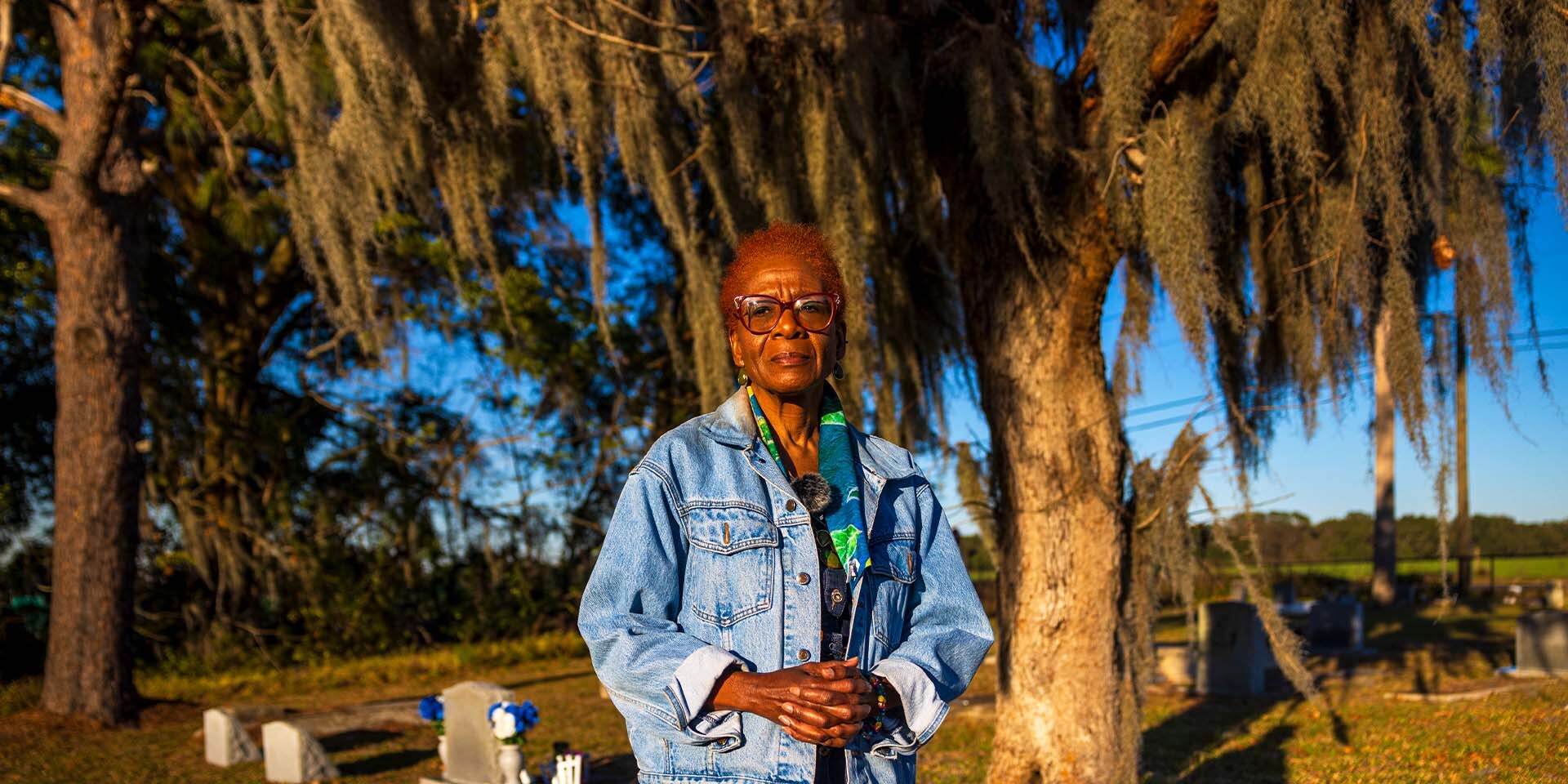When Suncara Jackson travels from Tallahassee back to the place she will always call home – the historically Black community of Royal in Central Florida – she sometimes shuts her eyes against the glare of the sun and tries to imagine what it was like.
What was it like for her great-great-grandfather Jim Patterson to make his way in the years after the Civil War from the plantation he was born on in Waycross, Georgia, to Royal, where he would become one of the few newly freed Black Americans granted land by the U.S. government under the Homestead Act of 1862?
What was it like for the scores of other newly freed men who settled in Royal, hacking their way through dense thickets of sea grape and prickly pear and, through their labors, into ownership of government-deeded parcels of 40 to 160 acres each?
What was it like for the descendants of the original founders to somehow hold on to their land, even as the promise of the early years of Reconstruction gave way to white nationalist violence, and the few other communities of Black homesteaders in the country were wiped out by racial terror and development-led displacement?
What was it like for the people of Royal to survive when that terror closed in and the Black community in Ocoee, just 50 miles away, was wiped out in 1920 by a white mob? And when Rosewood, another Black community 77 miles away, was burned to the ground three years later?
One thing Jackson can see without closing her eyes is what it is like to live in fear that all her ancestors built in Royal – the rich stories that were handed down to her, the deep sense of family among a community of people who have maintained ties for generations, the pride of having endured – is again under threat.
Last year, it was the turnpike extension the Florida Department of Transportation wanted to route right through Royal. No sooner had residents staved off that plan, at least for the time being, than several plots of agricultural land were rezoned by county officials to accommodate industrial use that could bring pollution and increased traffic to the tranquil community.
Then, a small minority of white landowners who have acquired parcels in Royal over the years opposed including their properties in the community’s bid to be listed on the National Register of Historic Places. In contrast, the bid has been endorsed by almost all of Royal’s 1,200 Black residents, as well as by many residents in surrounding communities.
Recently, the community turned to the Southern Poverty Law Center for help. The SPLC is providing legal representation, policy guidance and communications support to uplift the community’s efforts to preserve its history and land.
“To see and hear the things that are going on now, I feel like we are going backwards,” said Jackson, 42. “I have generations of ties to this land. It’s land that, after being born into slavery and being sharecroppers, my family has worked for, and it’s ours. And to have someone come in and try to take something from you, it’s like you’re taking away our history, like you don’t value us as human beings.”
Drumbeat quickening
So far, Sumter County has not recognized Royal, an unincorporated area within the county’s borders, as a historic resource. The county’s comprehensive land-use plan lacks any reference to Royal’s history. That gap has made it easy for developers to seek and win rezoning of land in Royal that would allow agricultural acreage to be turned into commercial and industrial lots and housing units. Pressure to build in the county is intense. Royal is just 60 miles south of Gainesville. The Villages, among the largest retirement communities in the country, is just six miles away and expanding fast.
The drumbeat of threats to Royal is quickening even as historical evidence of its uniqueness has emerged. Historians say Royal is the only rural community founded by Black homesteaders after the Civil War to survive with its landscape largely unchanged and the original plots overwhelmingly in the hands of descendants of the founding homesteaders.
Malissa Williams, a senior staff attorney with the SPLC’s Economic Justice Project, said advocating on behalf of the Royal community upholds the SPLC’s mission of preserving historically Black communities and properties, and supporting the building of Black intergenerational wealth.
“Rosewood is gone. Black Wall Street is gone. This is one of the last few remaining Black communities left largely intact since emancipation,” Williams said. “Rather than waiting around for this land to be taken away and then trying to get it back, let’s try and preserve it on the front end. And let’s make sure that these Black property owners continue to have the ability to pass on this very valuable land for generations to come.”
‘About heritage’
The descendants of the homesteaders who built Royal have no intention of giving up on their community, nor on its future.
Residents have long passed down oral histories from one generation to the next. Even as the community began to evolve from primarily agricultural to mixed uses in the late 1980s, residents maintained their farming traditions. Families still grow sugarcane, tomatoes and other crops for their own use, still teach their children how to bundle the cane and then reward them with a sweet length to chew on. Tobacco leaves are still hung to dry in sheds that dot the landscape, set amid modest houses and mobile homes.
Community members still gather in Royal’s churches every Sunday and at a community heritage celebration annually on Father’s Day. When an interstate highway bisected Royal in the 1950s – the sort of infrastructure project that has destroyed the fabric of other Black communities – the people of Royal were undeterred, residents say. They started making it a tradition to cross the overpass that bridges the highway to get to church and to visit neighbors.
And residents still greet people they haven’t met before with the question that most defines them: “Who are your people?”
Over the past decade or so, the oral histories and traditions have begun to solidify with historical research. That is largely due to the efforts of Beverly Steele, who was raised in the community, left to build a series of businesses in New York and California, and moved back in 1992.
Steele, 66, grew up on land her ancestors acquired under the Homestead Act. She remembers prayers in church always including thanks to God for the land that helped families feed their children. She remembers how the farmers of Royal would invite neighbors in lean times to glean their fields after they were done harvesting. She remembers how the women would get together to cook meals or do the washing for families in need. She remembers hearing her aunt recite the history of Royal at community churches and the Annual Royal Homecoming.
But Steele said it wasn’t until she came back to Royal to care for an aging family member that she began to appreciate the community’s history – and how to apply it today.
“Just like my forefathers and mothers gained their own strength in having concern and compassion for others, in making certain that everyone benefited in the community, I want to do my part preserving and protecting the characteristics of this place,” Steele said. “We don’t want riches, it’s not the money. We just want to keep the land from being developed for industrial use, for housing developments, we want development that reflects the historic characteristics of the community. This is about legacy, yes. This is about heritage, yes. This is about passing on what our forefathers and mothers passed on to us.”
‘Completely forgotten’
Steele’s journey to lead the historic preservation efforts began in 2009, when she and other residents went to the county with a request. They asked officials for funding to convert Royal’s shuttered school building – built in 1950 to educate Black children and closed after schools were integrated – into a cultural center that would benefit the community. Two years later, when Steele launched a nonprofit arts enrichment organization, Young Performing Artists Inc., in the former cafeteria of the school, she asked residents to share family histories and artifacts about Royal.
Steele was amazed at what turned up. Ever since, she has been delving further into her research. What began with inquiries to friends and neighbors grew into work with the state historic preservation officer. Then Steele secured a grant from the state of Florida to conduct a cultural resource assessment survey. Using the grant money, she hired the historian most responsible for uncovering the history of Rosewood – Dr. Edward González-Tennant, now an assistant professor at the University of Texas, Rio Grande Valley – to dig deeper into Royal’s history.
“A lot of people who study African American history have never heard of Royal,” González-Tennant said. “It’s a perfect example of the types of contributions African Americans had made to American history that have been completely forgotten, erased. Now we have the opportunity to undo that erasure. Anytime we have a place that physically embodies that contribution, all of us – historians, historical preservationists, all of us doing this sort of preservation work – have an obligation to document that as a way to retrieve Black contributions to American history.”
The work has paid off.
Two years ago, Suncara Jackson’s uncle, Maxwell Jackson, and other descendants of Jim Patterson successfully applied to the Sumter County Board of Commissioners to have a stretch of county road that goes through the Patterson homestead named in Jim Patterson’s honor.
The honorary designated roadway, Jim Patterson Lane, is one of only two county roads in Royal that run through property owned by descendants of original homesteaders. Royal residents know that area as “The Patt Quarters.” The other is named in honor of Dillie Bryant, the only woman to receive a land patent in Royal in the late 1800s.
Historic designation
The larger battle has been to get Royal’s historic importance recognized by state and federal authorities. On that score, too, there is significant progress but also points of contention.
Steele, on behalf of Young Performing Artists, proposed Royal for listing on the National Register of Historic Places in the areas of Ethnic Heritage: Black, Exploration/Settlement, Community Planning and Development, and Agricultural, at the local, state, and national levels of significance, for the period of significance 1870-1972. The National Register is administered by the National Park Service. But nominations to it must first be reviewed on the state government level, by the state’s historic preservation officer.
Marshaling the results of years of historic and geographic study, González-Tennant prepared the application on behalf of Young Performing Artists and submitted it to the Florida state historic preservation officer. In June, the Florida office submitted the application to the National Park Service. If the park service approves the application, Royal would become the first such rural district in Florida.
As González-Tennant wrote in the historic register application, “Few free Black rural towns founded during Reconstruction survive, and fewer still retain their agricultural practices into the late 20th or 21st centuries. Similar rural African American towns, such as Rosewood and Santos, were either directly destroyed through racial violence or displaced through development. As such, Royal is one of the most compelling examples of a rural, historically African American community in Florida. … Educating the next generation about historic agricultural practices and commemorating African American history is crucial to understanding the significance of Royal in a state where few similar communities exist to the present.”
While the designation would not prohibit landowners from developing their properties, Steele and others hope it will raise the profile of the community and make it more difficult for developers to justify encroaching on the historic area.
The process of getting the historic designation application to this point has not been without controversy. As originally submitted by González-Tennant and Young Performing Artists, the proposed historic district comprised 3,500 acres of land. But after white property owners whose lands were included in the historic district complained – despite ample evidence of the historic Black ownership or use of their properties – Young Performing Artists compromised, revising the acreage of the historic boundaries to 2,700 acres.
González-Tennant’s calculations show that despite the state’s final nomination reporting the boundaries as encompassing 2,500 acres, the boundaries cited only represent about 1,945 acres.
While they gave their approval to Florida’s nomination, neither Young Performing Artists nor González-Tennant are satisfied with the boundaries as submitted by the state, putting them in the unusual position of asking for a substantive review of their own nomination.
On July 19, González-Tennant petitioned the keeper of the National Register of Historic Places to compare the boundaries of the Royal historic district set forth in Young Performing Artists’ most recent application with those delineated in the state’s final nomination. He also asked the keeper to reconsider Royal’s historical significance, writing in his petition, “My research suggests Royal is nationally significant, but Florida [state historic preservation officer] staff have repeatedly downplayed Royal’s significance [by] listing it as local and then state.”
The SPLC agreed to represent Young Performing Artists and file a petition on its behalf, asking the keeper to conduct a substantive review of the Florida state historic preservation officer’s nomination on similar grounds.
Meanwhile, Steele, in collaboration with another community organization and residents, is petitioning the county to recognize the historic boundaries of Royal in its comprehensive plan. She and other residents say they want to ensure that future development is both consistent with the history and culture of Royal, while allowing landowners to maintain and increase the value of their land for themselves and their descendants.
“To me the history of Royal is about much more than just an African American community,” Steele said. “It is about an African American community that traces its story from the freedmen of 1865 up to the present day. It’s not about just this community. It’s about the life of freedmen in the state of Florida and across this nation.”
Photo at top: In a 2021 photo, descendants of Jim Patterson celebrate the naming of a road in Royal, Florida, in his honor. From left: great-great-great-grandson Travel Williams Jr., great-grandson Dwight Jackson, great-granddaughter Shameka Herring, great-granddaughter Yvette Lundy, great-grandson Maxwell Jackson and great-granddaughter Antoinette Corbin. (Credit: Villages-News.com)






